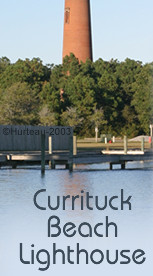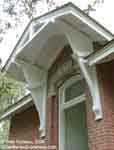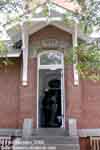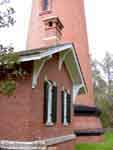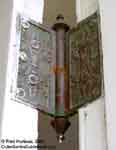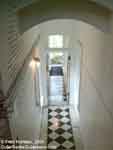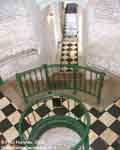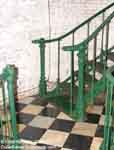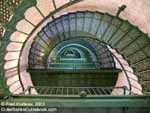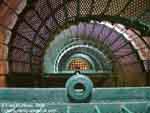 |
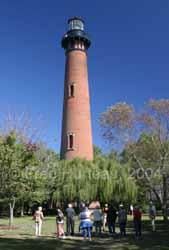 Currituck
Beach Lighthouse
Currituck
Beach Lighthouse
Fact Sheet:
- Completed
- (activated) Dec. 1, 1875
- Height
to top - 162 ft.
- Height
to focal plane - 158 ft.
- Beacon
Type - First order Polygonal Fresnel lens, 1000 watt light
- Beacon
distance - 18-19 nautical miles (about 16.5 statute miles)
- Light
pattern - On 3 sec./Off 17 sec. - dusk to dawn
- No.
of lighthouse steps - 214
- Open
to public to climb - Yes (approx. Easter through Thanksgiving)
- Location
- Corolla: 36° 22'36" N latitude, 75° 49'51'W
longitude
(at beacon - N 36.37684 W 75.83069
or 36° 22'14.44"N 75° 49'50.48")
- Keeper's
House - Not open to public. The only surviving Victorian
stick style grand Double Keepers Quarters of three ever
built by the U.S. Lighthouse Board. Exterior restored. Interior
mostly restored, but not period furnished at this time.
- Management
- Beacon operation maintained by the U.S. Coast Guard. Lighthouse
and grounds owned by the non-profit group Outer
Banks Conservationists, Inc.
- How
to get there - From US 158 at Martin's Point (between Kitty
Hawk and Southern Shores), take Highway 12 north 21.5 miles
to Corolla. Turn left into the Whalehead Club entrance and
then right at the "guard house". This drive takes you around
to the lighthouse parking and entrance. Or you can turn
left just past the Whalehead Club entrance onto Corolla
Village Road between the Whalehead Club and the lighthouse.
|
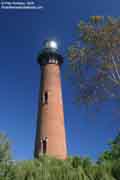 Currituck
Beach Lighthouse is certainly the most elegant of North Carolina's
lighthouses. It was the third of three lighthouses built under
the skilled supervision of Dexter Stetson, who was construction
forman for the Cape Hatteras and Bodie Island lighthouses as
well.
Currituck
Beach Lighthouse is certainly the most elegant of North Carolina's
lighthouses. It was the third of three lighthouses built under
the skilled supervision of Dexter Stetson, who was construction
forman for the Cape Hatteras and Bodie Island lighthouses as
well.
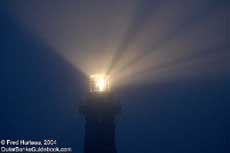 |
| Currituck's
beacon pierces a foggy, rainy night. Note the beams project
only to the east toward the ocean. |
As fate would have it, construction on Currituck Beach
Lighthouse had only begun the year Cape Lookout, Cape Hatteras
and Bodie Island received their black and white markings. So
Currituck was spared from the painters brush, and stands today
as bare red brick. But it's this very distinction that not only
lets us see what the others once looked like, but allows the
architectural dignity and detail of this brick marvel to be
appreciated.
Like
Bodie Island, this lighthouse has a First
Order Fresnel lens. When lit with its 1000 watt lamp, it
provides a comforting
site against the deep blue of a cool night sky. On a
foggy night the beacon's eastward orientation becomes evident. |
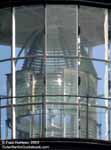 |
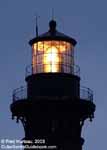 |
| Currituck's
First Order Fresnel lens. |
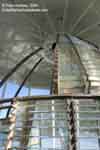 |
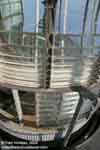 |
| These
photos show that some of the elements are not present
at the top and bottom on the west side of the Fresnel
lens (left of images). |
The
upper and lower lens elements are present only on the east side
of this non-rotating Fresnel lens, shown in the photos at left.
Alt Though the beacon is visible from all directions, the Fresnel
lens elements focus the light into an array of beams projected
eastward toward the ocean, providing greater visible range over
the Atlantic.
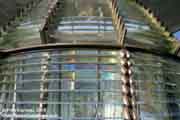
Much less visibility range is needed to
the west because Currituck Sound is only about seven miles wide,
and the lighthouse was never meant to be a warning to vessels
on the sound. Its purpose was to warn ships on the Atlantic
to stay away from the coast line, and to help them identify
their location by referencing the lighthouse. |
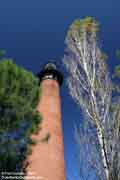 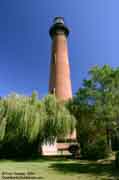 The
lighthouse
is a virtual twin in it's design and construction to Bodie Island
Lighthouse. Comparing these images below of the workroom/entrance
to those from the Bodie Island Lighthouse pages makes this quite
evident. The layout inside the workroom building and the detail
of the construction inside and outside the lighthouses are identical
in almost every respect. The
lighthouse
is a virtual twin in it's design and construction to Bodie Island
Lighthouse. Comparing these images below of the workroom/entrance
to those from the Bodie Island Lighthouse pages makes this quite
evident. The layout inside the workroom building and the detail
of the construction inside and outside the lighthouses are identical
in almost every respect.
The granite
arch over the entrance says "1873", the year construction
began. The eave
brackets, the brackets supporting the entrance roof, and
the Victorian
stick decoration over the entrance look identical to those
of Bodie Island's workroom. Everything was true to the Victorian
spirit. Even the hinges
on the entrance door are ornately decorated, as shown in
the far right photo below.
|
 The
south workroom is now used as an office for ticket sales to
climb the lighthouse. The north
workroom is shown in the panoramic photo at left. It contains
a display of information and historical items. The photo at
immediate right shows the view
up the entrance hall, looking up the steps to the "well"
inside the base of the lighthouse. At far right is the view
from the "well" looking down the hallway to the entrance.
Note the hall floor is tiled in black and white marble, just
like the Cape Hatteras and Bodie Island Lighthouses.The hall
ceiling is high and arched, giving the feeling of great
space.
The
south workroom is now used as an office for ticket sales to
climb the lighthouse. The north
workroom is shown in the panoramic photo at left. It contains
a display of information and historical items. The photo at
immediate right shows the view
up the entrance hall, looking up the steps to the "well"
inside the base of the lighthouse. At far right is the view
from the "well" looking down the hallway to the entrance.
Note the hall floor is tiled in black and white marble, just
like the Cape Hatteras and Bodie Island Lighthouses.The hall
ceiling is high and arched, giving the feeling of great
space.
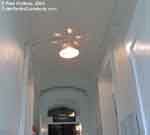 The "well"
is seen at right, viewed from the first flight of stairs, looking
out to the entrance hall. It is a circular depression in the
center of the floor. The weights that powered the beacon rotating
mechanism were lowered into the "well" for servicing of the
mechanism or cable. They worked similar to the weights that
are wound up to run a grandfather clock.
The "well"
is seen at right, viewed from the first flight of stairs, looking
out to the entrance hall. It is a circular depression in the
center of the floor. The weights that powered the beacon rotating
mechanism were lowered into the "well" for servicing of the
mechanism or cable. They worked similar to the weights that
are wound up to run a grandfather clock.
 |
| Waiting
to climb |
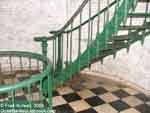 |

Click
any thumbnail for a larger view. |
Stair construction is identical to Bodie
Island Lighthouse, as well as the railing
and banister design details. Individual
risers bolt together to form the staircase, a technique
first seen in the Cape Hatteras Lighthouse. But unlike Cape
Hatteras which has alternating landings, both Currituck Beach
Lighthouse and Bodie Island Lighthouse stairs have landings
all on the same side. This allows a wonderful view up the center
of the stairwell, as seen in the photos looking
up the stairs (lower left), and looking
down (lower right).
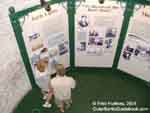 The
rings attached to the edge of each landing in the photos at
left are the guides for the cable which held the weight that
powered the beacon rotating mechanism. The far right photo shows
one of the large museum quality informational and historical
displays about Currituck Beach Lighthouse, the Keeper's
Quarters, the invention of the Fresnel lens, and about lighthouses
in general. These are located on the first floor, and the first
two landings. The
rings attached to the edge of each landing in the photos at
left are the guides for the cable which held the weight that
powered the beacon rotating mechanism. The far right photo shows
one of the large museum quality informational and historical
displays about Currituck Beach Lighthouse, the Keeper's
Quarters, the invention of the Fresnel lens, and about lighthouses
in general. These are located on the first floor, and the first
two landings.
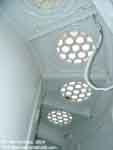 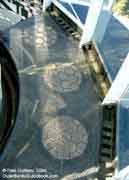 One detail that is surely missed by most
visitors is the interesting glass
skylights in the floor of the lantern room. These are seen
above the last flight of stairs as you reach the door leading
out to the gallery. Since this flight of stairs wraps around
the mechanical room, which is encased in metal, no light reaches
here from the lower windows in the lighthouse. These skylights
let in daylight from above, and also allow the beacon light
to illuminate this last flight of steps at night. At right is
a photo of those same skylights
viewed from the lantern room, inset into the floor. This
is but another example of the detail and workmanship that went
into the construction of not only this lighthouse, but Bodie
Island and Cape Hatteras lighthouses as well. The large cable
in the photo is a grounding cable for the lighting rod.
One detail that is surely missed by most
visitors is the interesting glass
skylights in the floor of the lantern room. These are seen
above the last flight of stairs as you reach the door leading
out to the gallery. Since this flight of stairs wraps around
the mechanical room, which is encased in metal, no light reaches
here from the lower windows in the lighthouse. These skylights
let in daylight from above, and also allow the beacon light
to illuminate this last flight of steps at night. At right is
a photo of those same skylights
viewed from the lantern room, inset into the floor. This
is but another example of the detail and workmanship that went
into the construction of not only this lighthouse, but Bodie
Island and Cape Hatteras lighthouses as well. The large cable
in the photo is a grounding cable for the lighting rod. |
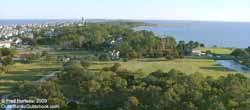 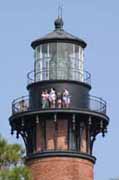 Once
you reach the top of Currituck Beach Lighthouse, you find that
the view is well worth the climb. The barrier island is narrow
here, affording spectacular views of both the sound and the
ocean, as exemplified at left in the photo looking
south. On a clear day with good binoculars you can see more
than 15 miles south beyond Duck, perhaps as far as Southern
Shores. In the original large format photo if the image at left,
the water tower at Duck is easily identified, as is another
water tower and other structures farther south that have not
yet been researched for an identity.
Once
you reach the top of Currituck Beach Lighthouse, you find that
the view is well worth the climb. The barrier island is narrow
here, affording spectacular views of both the sound and the
ocean, as exemplified at left in the photo looking
south. On a clear day with good binoculars you can see more
than 15 miles south beyond Duck, perhaps as far as Southern
Shores. In the original large format photo if the image at left,
the water tower at Duck is easily identified, as is another
water tower and other structures farther south that have not
yet been researched for an identity.
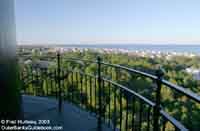 Looking
northeast
over the village of Corolla in the photo at right, the residences
along the beach appear to end. This is where the north end of
NC Hwy. 12 terminates at a beach access ramp. It is also where
the horse fence crosses the island from sound to ocean, to keep
the wild horses safe from the dangers of traffic along NC 12.
North of here is 4WD traffic only. The only highway is the beach,
and the only roads are dirt and sand to reach many more homes
farther north in the communities of Swan Beach, North Swan Beach
and Carova. To learn more about this area north, read about
"Finding
The Wild Horses of Corolla". Looking
northeast
over the village of Corolla in the photo at right, the residences
along the beach appear to end. This is where the north end of
NC Hwy. 12 terminates at a beach access ramp. It is also where
the horse fence crosses the island from sound to ocean, to keep
the wild horses safe from the dangers of traffic along NC 12.
North of here is 4WD traffic only. The only highway is the beach,
and the only roads are dirt and sand to reach many more homes
farther north in the communities of Swan Beach, North Swan Beach
and Carova. To learn more about this area north, read about
"Finding
The Wild Horses of Corolla".
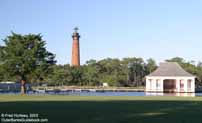  Looking
south again, the next door neighbor to the lighthouse grounds
is the historic Whalehead
Club property, now being restored and operated by Currituck
County as a recreational and historic area. This provides an
additional scenic gem to appreciate from atop the lighthouse,
as well as some great vistas of the lighthouse
from the Whalehead Club grounds. Looking
south again, the next door neighbor to the lighthouse grounds
is the historic Whalehead
Club property, now being restored and operated by Currituck
County as a recreational and historic area. This provides an
additional scenic gem to appreciate from atop the lighthouse,
as well as some great vistas of the lighthouse
from the Whalehead Club grounds. |
This
aerial view, courtesy of the National Oceanic and Atmospheric
Administration, will provide a good visual orientation between
the lighthouse property and Whalehead Club grounds. In September,
2003, just after Hurricane Isabel, NOAA took aerial photos of
the entire Outer Banks, including all the lighthouses. Though
these photos have been reduced somewhat, they are still quite
large.
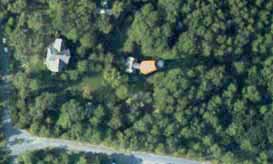 |
The
thumbnail at left is actual size and was "cropped" from
the large photo. The full image shows Currituck
Beach Lighthouse and the entire Whalehead Club property
next to it.
In this image, the far left gray
object is the duplex Keepers Quarters. The tan object
in the center is the lighthouse. The lighthouse shadow
stretches from the lighthouse toward the right side of
the image. |
|
Next,
the unique beauty of the Currituck Beach Light Station is revealed
in the immaculate landscaping and Victorian Keeper's house.
CarolinaOuterBanks.com is very pleased to bring you
exclusive photos of some of the interior of this grand duplex
Keeper's house on the next page. |

Continue
to Currituck Beach Lighthouse - Page
Two > |
Currituck
Beach
Lighthouse |
 |
|

